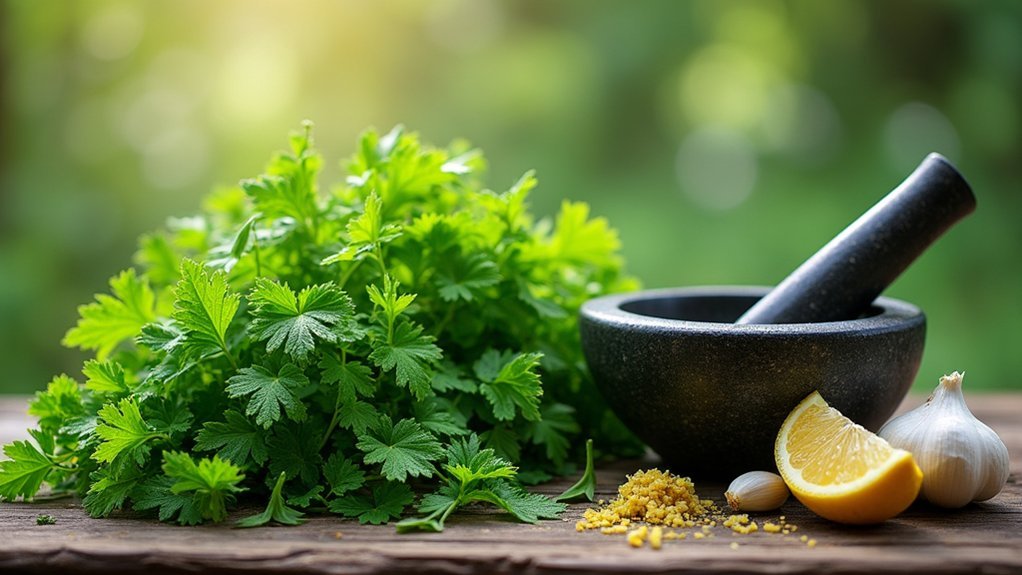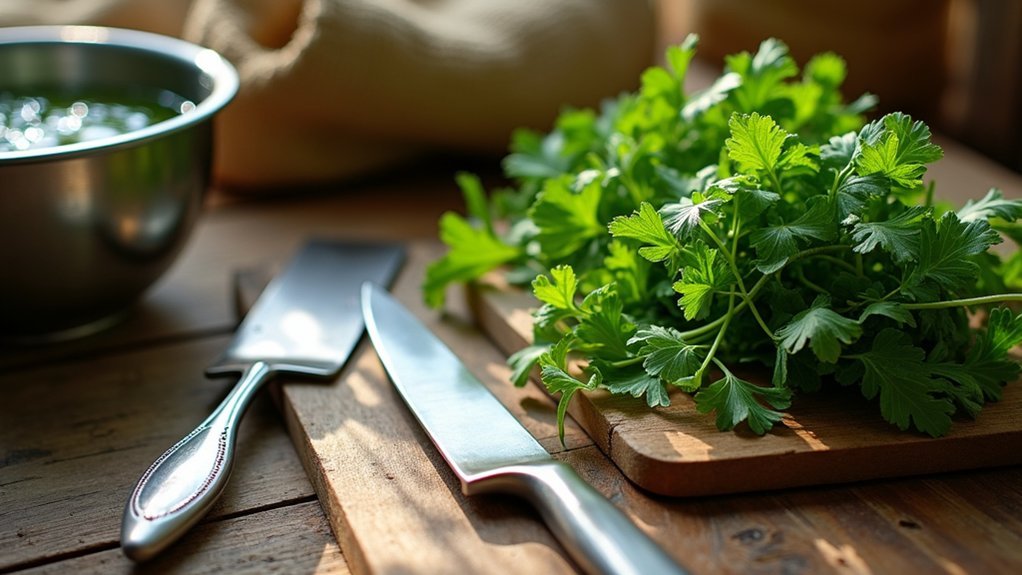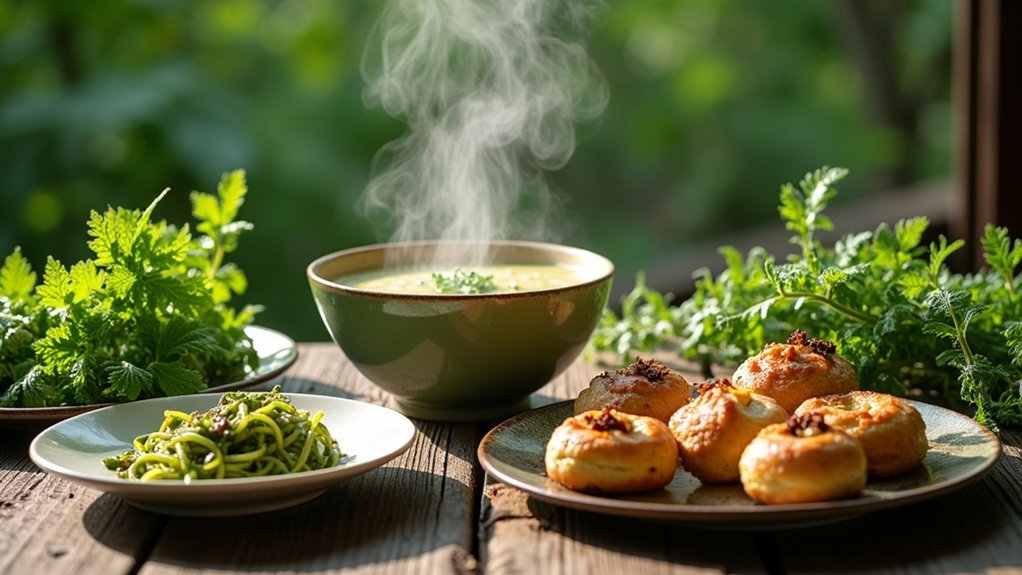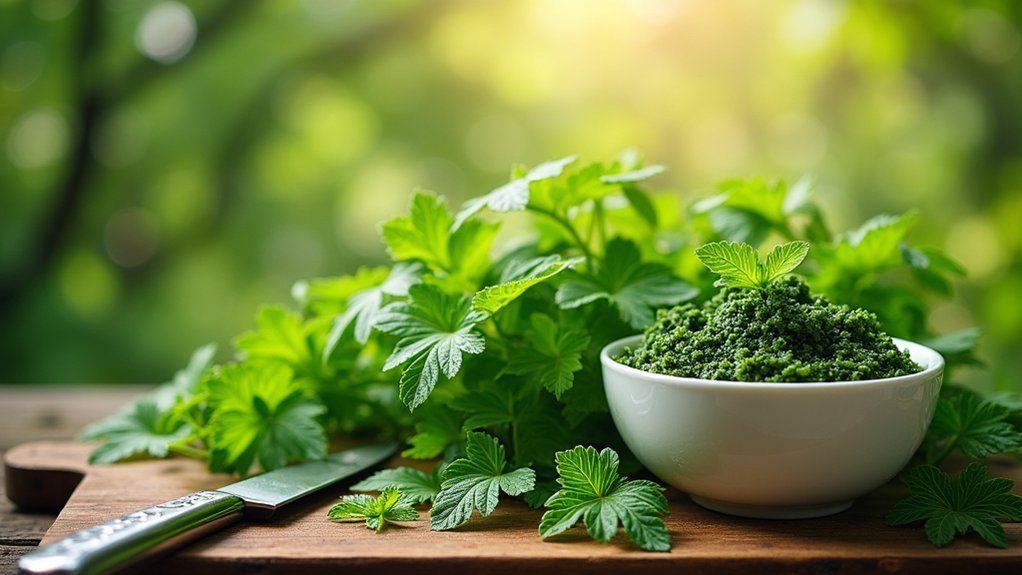Wild nettles transform into nutritious food with proper handling. You'll need gloves to harvest young plants in spring, picking just the top 6 inches. Blanch them in boiling water for 2 minutes to neutralize the sting, then shock in ice water. Once processed, nettles work in soups, sautés, pasta dishes, and even breakfast recipes. Their high protein, vitamin, and mineral content makes them worth the extra preparation effort. The versatile applications might surprise you.
5 Second-Level Headings for "Turn Wild Nettles Into Food: Complete Guide"

While creating a thorough guide on transforming wild nettles into food, you'll need clear, informative headings to organize your content effectively.
Consider these essential sections for your guide:
- What Are Stinging Nettles? (Nutrition & Benefits)
- When and How to Harvest Nettles Safely
- Preparing Nettles: Removing the Sting
- Basic Cooking Methods: Blanching & Sautéing
- Nettle Soup Recipes: High in Protein & Flavor
- Creative Uses: Nettle Pesto, Dumplings & More
- Preserving Nettles for Year-Round Use
- Seasonal Nettle Dishes: Spring Favorites
These headings guide readers from identification through harvesting, preparation, and cooking techniques, highlighting nettles' nutritional value and culinary versatility.
They'll help structure your guide logically, ensuring readers can confidently transform these nutrient-dense wild greens into delicious meals.
Identifying and Safely Harvesting Urban Nettles
Even though they've earned a reputation for their sting, urban nettles represent one of nature's most nutritious wild foods hiding in plain sight.
Beyond their fearsome reputation, urban nettles offer a nutritional goldmine waiting to be discovered by adventurous foragers.
Look for heart-shaped leaves with serrated edges and those telltale stinging hairs. Make sure you're harvesting in early spring to early summer before they flower, focusing on the top 6 inches where tender greens grow.
When collecting these prickly treasures, remember:
- Always wear gloves and long sleeves to protect yourself from the stinging hairs
- Harvest from pollution-free areas, away from roadways and pesticide use
- Seek out moist, disturbed areas like meadows and irrigation ditches
- Take only what you'll use, leaving plenty to maintain the plant population
Essential Equipment for Nettle Processing

Once you've spotted and gathered your urban nettle bounty, you'll need the right tools to transform these stinging plants into kitchen-ready ingredients.
Start with sturdy gloves to protect your hands and sharp scissors for cutting leaves. Prepare a large bowl for washing your harvest thoroughly.
You'll need access to boiling water for blanching, which neutralizes the sting while preserving nutrients and vibrant green color. An ice water bath is essential for shocking the blanched nettles, stopping the cooking process immediately.
Keep a colander handy for effective draining and rinsing.
For storage, airtight containers or vacuum-seal bags will maintain freshness of your processed nettles.
These simple tools make the difference between painful weeds and delicious, nutritious greens you can confidently store and use in countless recipes.
Blanching and Preparing Nettles for Culinary Use
After gathering your wild nettles, proper blanching transforms these stinging plants into versatile culinary ingredients.
Always wear gloves when handling fresh nettles to avoid their painful sting. Select tender leaves from the tops of plants, especially in early spring when they're most nutritious.
To prepare nettles for cooking:
- Wash thoroughly in cold water to remove dirt and insects
- Blanch in salted boiling water for 2 minutes to deactivate stinging hairs
- Shock the nettles in ice water to stop the cooking process
- Drain and strip leaves from stems for use in recipes
Your blanched nettles will keep in the refrigerator for up to a week, or freeze them in vacuum-sealed bags for longer storage while preserving their nutritional benefits.
Versatile Nettle Recipes for Every Meal

Now that your nettles are blanched and ready, you'll find these tender greens can transform your meals from ordinary to extraordinary. This wild edible packs remarkable nutritional value and herbal medicine benefits in every bite.
Start with nettle pesto—blend nettle leaves with parmesan, lemon, pine nuts, and garlic for a pasta topping that rivals traditional basil versions.
For comforting meals, try pureed nasselsoppa, where nettles enhance soups with their earthy flavor, particularly alongside potatoes.
You can easily substitute nettle leaves for spinach in lasagna or gnocchi, gaining superior nutrition without sacrificing texture.
For breakfast, whip up savory nettle pancakes using blanched leaves, flour, and eggs.
Even simple dishes like Irish colcannon become special when you add steamed nettles to mashed potatoes, making uses for stinging nettles virtually limitless.
Frequently Asked Questions
How to Prepare Nettles for Eating?
To prepare nettles for eating, wear gloves, harvest young tops, rinse thoroughly, then blanch in boiling water for 1-2 minutes. This deactivates their sting. Strip leaves from stems before using in your recipes.
How Do You Make Plant Food From Nettles?
You'll make nettle fertilizer by chopping fresh nettles, submerging them in water for 3-4 weeks, straining the liquid, then diluting it 1:10 with water before applying to your plants every few weeks.
When Should You Not Eat Nettles?
You shouldn't eat nettles after they've flowered, from polluted areas, or if you're allergic to the Urticaceae family. Don't consume them raw or in large quantities if you're not used to high-fiber foods.
What Are the Side Effects of Eating Stinging Nettles?
You might experience allergic reactions, skin rashes, or digestive discomfort when eating nettles. If you don't cook them properly, they'll irritate your mouth. They can also interact with blood thinners and cause nausea in large amounts.
In Summary
You've now got everything you need to transform those pesky urban nettles into delicious, nutritious meals. Don't let their sting intimidate you—with proper harvesting techniques and the right equipment, you'll soon be enjoying nettle soups, pestos, and teas. Start small, experiment with different recipes, and you'll quickly discover why foragers worldwide treasure this versatile wild green. Happy foraging and bon appétit!





Leave a Reply